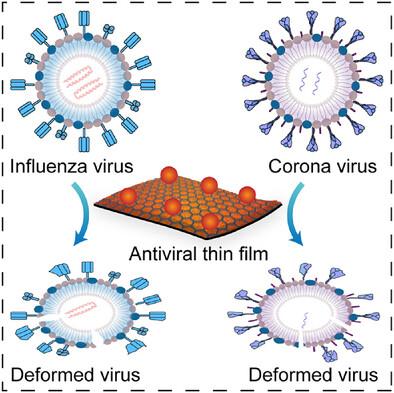Nanoparticles-Embedded Covalent Organic Framework Thin Films for Sequestrating Viral Pathogens
IF 19
1区 材料科学
Q1 CHEMISTRY, MULTIDISCIPLINARY
引用次数: 0
Abstract
Developing non-toxic, efficient, and environment-friendly microbe-resistant surfaces for viral infections is crucial, considering the lengthy and complex drug development process. Here, a highly efficient antiviral material is developed with Fe3O4 nanoparticles-embedded covalent organic framework (COF) thin film. TpAzo-Fe3O4, the nanoparticles-embedded thin film, being a cost-effective, non-toxic, highly stable, and readily synthesized material, offers a more sustainable approach than the existing antiviral materials. The precise embedding of the nanoparticles on COF thin films provides stability and prevents coagulation in the experimental media. The antiviral potential of TpAzo-Fe3O4 thin film is evaluated against four viral prototypes, Influenza Type A/PR/8/1934 (H1N1), A/turkey/Wisconsin/1/1966 (H9N2) and Human Corona Virus (HCoV-OC43 and HCoV-NL63). Superior antiviral activity is recorded by the TpAzo-Fe3O4 thin film exhibiting nearly 72% cell viability against H1N1, ≈99% cell viability against H9N2, ≈94% cell viability against HCoV-OC43, and ≈ 98% against HCoV-NL63 virus. The importance of the COF thin film is apparent from a control experiment with Fe3O4 nanoparticles-loaded polymer (TpmXDA-Fe3O4). Finally, an “antiviral filtration” is performed with TpAzo-Fe3O4 film, and residual viral activity (H1N1 virus) of the filtrate is assessed. The results revealed nearly ≈95% cell viability, suggesting complete sequestration/containment of the test virus during filtration.

纳米颗粒-嵌入共价有机框架薄膜用于隔离病毒病原体
考虑到漫长而复杂的药物开发过程,开发无毒、高效、环保的耐微生物表面对病毒感染至关重要。本研究利用Fe3O4纳米颗粒包埋共价有机骨架(COF)薄膜开发了一种高效抗病毒材料。TpAzo-Fe3O4是一种低成本、无毒、高稳定性和易于合成的纳米颗粒薄膜,比现有的抗病毒材料提供了一种更可持续的方法。纳米颗粒在COF薄膜上的精确嵌入提供了稳定性,并防止在实验介质中凝固。研究了TpAzo-Fe3O4薄膜对甲型H1N1 /PR/8/1934 (H1N1)、甲型H1N1 /turkey/Wisconsin/1/1966 (H9N2)和人类冠状病毒(HCoV-OC43和HCoV-NL63)四种病毒原型的抗病毒潜力。TpAzo-Fe3O4薄膜具有较好的抗病毒活性,对H1N1病毒的细胞活性约为72%,对H9N2病毒的细胞活性约为99%,对HCoV-OC43病毒的细胞活性约为94%,对HCoV-NL63病毒的细胞活性约为98%。通过负载Fe3O4纳米粒子的聚合物(TpmXDA-Fe3O4)的对照实验,可以明显看出COF薄膜的重要性。最后,用TpAzo-Fe3O4薄膜进行“抗病毒过滤”,并评估滤液的残留病毒活性(H1N1病毒)。结果显示细胞存活率接近≈95%,表明在过滤过程中完全隔离/遏制了试验病毒。
本文章由计算机程序翻译,如有差异,请以英文原文为准。
求助全文
约1分钟内获得全文
求助全文
来源期刊

Advanced Functional Materials
工程技术-材料科学:综合
CiteScore
29.50
自引率
4.20%
发文量
2086
审稿时长
2.1 months
期刊介绍:
Firmly established as a top-tier materials science journal, Advanced Functional Materials reports breakthrough research in all aspects of materials science, including nanotechnology, chemistry, physics, and biology every week.
Advanced Functional Materials is known for its rapid and fair peer review, quality content, and high impact, making it the first choice of the international materials science community.
 求助内容:
求助内容: 应助结果提醒方式:
应助结果提醒方式:


